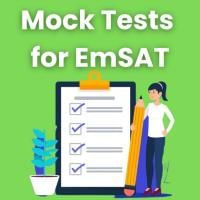EmSAT Achieve Exam > EmSAT Achieve Questions > A ball of mass 0.5kg is moving with velocity ...
Start Learning for Free
A ball of mass 0.5kg is moving with velocity 6.626 m/s. What’s the wavelength of that ball?
- a)1 x 10-34 m
- b)2 x 10-34 m
- c)2 x 10-32 m
- d)2 x 10-3 m
Correct answer is option 'B'. Can you explain this answer?
Verified Answer
A ball of mass 0.5kg is moving with velocity 6.626 m/s. What’s t...
Louis de Brogie gave the realation between momentum and wavelength as λ = h/p.
Here h is Planck’s constant, whose value is 6.626 x 10-34 J/s.
Wavelength = h/mv = 2 x 10-34 m (momentum p = mass m x velocity v).
Most Upvoted Answer
A ball of mass 0.5kg is moving with velocity 6.626 m/s. What’s t...
Given Data:
- Mass (m) = 0.5 kg
- Velocity (v) = 6.626 m/s
Formula:
The wavelength of an object can be calculated using the de Broglie wavelength formula:
λ = h / mv
where:
- λ is the wavelength
- h is the Planck's constant (6.626 x 10^-34 Js)
- m is the mass of the object
- v is the velocity of the object
Calculation:
- Substitute the given values into the formula:
λ = 6.626 x 10^-34 / (0.5 x 6.626)
λ = 6.626 x 10^-34 / 3.313
λ = 2 x 10^-34 m
Therefore, the wavelength of the ball is 2 x 10^-34 m. Hence, the correct answer is option B.
- Mass (m) = 0.5 kg
- Velocity (v) = 6.626 m/s
Formula:
The wavelength of an object can be calculated using the de Broglie wavelength formula:
λ = h / mv
where:
- λ is the wavelength
- h is the Planck's constant (6.626 x 10^-34 Js)
- m is the mass of the object
- v is the velocity of the object
Calculation:
- Substitute the given values into the formula:
λ = 6.626 x 10^-34 / (0.5 x 6.626)
λ = 6.626 x 10^-34 / 3.313
λ = 2 x 10^-34 m
Therefore, the wavelength of the ball is 2 x 10^-34 m. Hence, the correct answer is option B.

|
Explore Courses for EmSAT Achieve exam
|

|
Similar EmSAT Achieve Doubts
A ball of mass 0.5kg is moving with velocity 6.626 m/s. What’s the wavelength of that ball?a)1 x 10-34mb)2 x 10-34mc)2 x 10-32md)2 x 10-3mCorrect answer is option 'B'. Can you explain this answer?
Question Description
A ball of mass 0.5kg is moving with velocity 6.626 m/s. What’s the wavelength of that ball?a)1 x 10-34mb)2 x 10-34mc)2 x 10-32md)2 x 10-3mCorrect answer is option 'B'. Can you explain this answer? for EmSAT Achieve 2025 is part of EmSAT Achieve preparation. The Question and answers have been prepared according to the EmSAT Achieve exam syllabus. Information about A ball of mass 0.5kg is moving with velocity 6.626 m/s. What’s the wavelength of that ball?a)1 x 10-34mb)2 x 10-34mc)2 x 10-32md)2 x 10-3mCorrect answer is option 'B'. Can you explain this answer? covers all topics & solutions for EmSAT Achieve 2025 Exam. Find important definitions, questions, meanings, examples, exercises and tests below for A ball of mass 0.5kg is moving with velocity 6.626 m/s. What’s the wavelength of that ball?a)1 x 10-34mb)2 x 10-34mc)2 x 10-32md)2 x 10-3mCorrect answer is option 'B'. Can you explain this answer?.
A ball of mass 0.5kg is moving with velocity 6.626 m/s. What’s the wavelength of that ball?a)1 x 10-34mb)2 x 10-34mc)2 x 10-32md)2 x 10-3mCorrect answer is option 'B'. Can you explain this answer? for EmSAT Achieve 2025 is part of EmSAT Achieve preparation. The Question and answers have been prepared according to the EmSAT Achieve exam syllabus. Information about A ball of mass 0.5kg is moving with velocity 6.626 m/s. What’s the wavelength of that ball?a)1 x 10-34mb)2 x 10-34mc)2 x 10-32md)2 x 10-3mCorrect answer is option 'B'. Can you explain this answer? covers all topics & solutions for EmSAT Achieve 2025 Exam. Find important definitions, questions, meanings, examples, exercises and tests below for A ball of mass 0.5kg is moving with velocity 6.626 m/s. What’s the wavelength of that ball?a)1 x 10-34mb)2 x 10-34mc)2 x 10-32md)2 x 10-3mCorrect answer is option 'B'. Can you explain this answer?.
Solutions for A ball of mass 0.5kg is moving with velocity 6.626 m/s. What’s the wavelength of that ball?a)1 x 10-34mb)2 x 10-34mc)2 x 10-32md)2 x 10-3mCorrect answer is option 'B'. Can you explain this answer? in English & in Hindi are available as part of our courses for EmSAT Achieve.
Download more important topics, notes, lectures and mock test series for EmSAT Achieve Exam by signing up for free.
Here you can find the meaning of A ball of mass 0.5kg is moving with velocity 6.626 m/s. What’s the wavelength of that ball?a)1 x 10-34mb)2 x 10-34mc)2 x 10-32md)2 x 10-3mCorrect answer is option 'B'. Can you explain this answer? defined & explained in the simplest way possible. Besides giving the explanation of
A ball of mass 0.5kg is moving with velocity 6.626 m/s. What’s the wavelength of that ball?a)1 x 10-34mb)2 x 10-34mc)2 x 10-32md)2 x 10-3mCorrect answer is option 'B'. Can you explain this answer?, a detailed solution for A ball of mass 0.5kg is moving with velocity 6.626 m/s. What’s the wavelength of that ball?a)1 x 10-34mb)2 x 10-34mc)2 x 10-32md)2 x 10-3mCorrect answer is option 'B'. Can you explain this answer? has been provided alongside types of A ball of mass 0.5kg is moving with velocity 6.626 m/s. What’s the wavelength of that ball?a)1 x 10-34mb)2 x 10-34mc)2 x 10-32md)2 x 10-3mCorrect answer is option 'B'. Can you explain this answer? theory, EduRev gives you an
ample number of questions to practice A ball of mass 0.5kg is moving with velocity 6.626 m/s. What’s the wavelength of that ball?a)1 x 10-34mb)2 x 10-34mc)2 x 10-32md)2 x 10-3mCorrect answer is option 'B'. Can you explain this answer? tests, examples and also practice EmSAT Achieve tests.

|
Explore Courses for EmSAT Achieve exam
|

|
Signup for Free!
Signup to see your scores go up within 7 days! Learn & Practice with 1000+ FREE Notes, Videos & Tests.


























